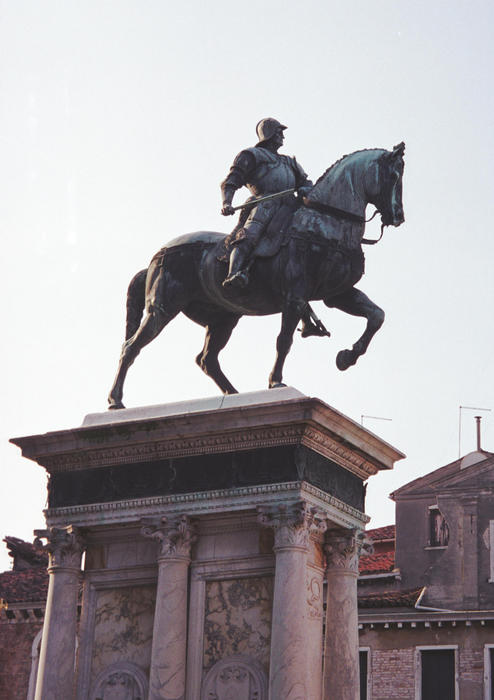There's a statue in Venice that my father was fascinated by - although he never saw it in person. I saw it in Venice in 2003 and in turn have become fascinated. It's of Condottiero Bartolomeo Colleoni. What fascinates me isn't just the sculpture by Verrocchio (which is great), but the story of how it came into being. I'm going to crib this almost entirely from a small number of pages on Wikipedia: you can read them yourself if you prefer, I'll link them in the Bibliography.
My mediocre picture of the Colleoni statue.

Bartolomeo Colleoni was born near Milan in 1400, and trained as a soldier. He was a mercenary, and spent most of his career in the wars between Milan and Venice. One might assume he fought for Venice given the statue, but like most things about this story, it's not that simple. He switched sides several times. He was never accused of treachery, because he always switched sides in the interludes between the wars. He was a "condottiero," the captain of a mercenary company: the term derives from "condotta," the contract under which the soldiers worked for the city lords. He was apparently an extraordinary tactician. He spent his later years working mostly for Venice and retired there, having amassed a considerable fortune. When he died in 1475, he left a large sum of money to the city for their current war, and requested an equestrian statue of himself be placed in Piazza San Marco. Which is a big ask: it was the heart of the city then as it is now.
The city lords seem to have been happy enough taking the money, and did commission the sculpture ... but city rules said no sculptures in Piazza San Marco. So the sculpture of a mercenary ended up in Campo Santi Giovanni e Paolo.
Andrea del Verrocchio was the sculptor from Firenze (Florence) who was commissioned to create the sculpture. It's fairly certain he had never seen Colleoni - so the sculpture is "not a portrait of the man but of the idea of a strong and ruthless military commander ..." The sculpture took so long that Verrocchio died (in 1488) before it was completed. Verrocchio had asked that his student complete it, but the city of Venice finally decided on Alessandro Leopardi, who completed the statue in 1496.
What makes it a great sculpture is not only the technical quality (it shows an accurate horse, and an accurate armoured rider), but the sense of presence you get from it. You know by looking at the sculpture that this guy was an imperious bastard who was accustomed to getting respect - or any damn thing he wanted. And you have to feel that the obnoxious personality this presents may not be what Colleoni wanted, but it's probably what he deserved.